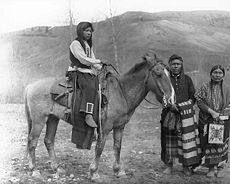.gif)
Palus (tribe)
Encyclopedia

- For the district in India, see PalusPalusPalus is a tehsil Sangli district in the Indian state of Maharashtra.PALUS is a nice village. Palus has an industrial area & a wine park. Palus MIDC is the biggest asset for Palus, which holds major component manufacturing. Kirloskar brothers ltd.is near to Palus. Palus tahashil have more famous...
.
The Palus (icon) are a Sahaptin
Sahaptin people
The Sahaptin people are a Native American people that inhabited territory along the Columbia River. The Nez Perce tribe is one of the major Sahaptin groups.-Territory:...
tribe recognized in the Treaty of 1855 with the Yakamas (negotiated at the Walla Walla Council (1855)
Walla Walla Council (1855)
The Walla Walla Council was a meeting in the Pacific Northwest between the United States and sovereign tribal bodies of the Cayuse, Nez Perce, Umatilla, Walla Walla, and Yakama. The treaties signed at this council were ratified by the U.S. Senate in 1859...
). A variant spelling is Palouse
Palouse
The Palouse is a region of the northwestern United States, encompassing parts of southeastern Washington, north central Idaho and, in some definitions, extending south into northeast Oregon. It is a major agricultural area, primarily producing wheat and legumes...
, which was the source of the name for the fertile prairie of Washington and Idaho
Idaho
Idaho is a state in the Rocky Mountain area of the United States. The state's largest city and capital is Boise. Residents are called "Idahoans". Idaho was admitted to the Union on July 3, 1890, as the 43rd state....
.
Ethnography
The people are one of the SahaptinSahaptin language
Sahaptin , Sħáptənəxw, is a Plateau Penutian language of the Sahaptian branch spoken in a section of the northwestern plateau along the Columbia River and its tributaries in southern Washington, northern Oregon, and southwestern Idaho....
speaking groups of Native Americans living on the Columbia Plateau
Columbia River Plateau
The Columbia Plateau is a geologic and geographic region that lies across parts of the U.S. states of Washington, Oregon, and Idaho. It is a wide flood basalt plateau between the Cascade Range and the Rocky Mountains, cut through by the Columbia River...
in eastern Washington, northeastern Oregon
Oregon
Oregon is a state in the Pacific Northwest region of the United States. It is located on the Pacific coast, with Washington to the north, California to the south, Nevada on the southeast and Idaho to the east. The Columbia and Snake rivers delineate much of Oregon's northern and eastern...
, and North Central
North Central Idaho
North Central Idaho is an area which spans the central part of the state of Idaho and borders Oregon, Montana, and Washington. It is the southern half of the Idaho Panhandle region and is rich in agriculture and natural resources. Lewis and Clark travelled throughout this area on their journey to...
Idaho
Idaho
Idaho is a state in the Rocky Mountain area of the United States. The state's largest city and capital is Boise. Residents are called "Idahoans". Idaho was admitted to the Union on July 3, 1890, as the 43rd state....
.
The people of the region lived in three main groups, the Upper, Middle, and Lower bands. Traditional lands included areas around waterways such as the Columbia, Snake and Palouse Rivers.
The ancestral people were nomadic, following food sources through the seasons. The Palus people gathered with other native peoples for activities such as food-gathering, hunting, fishing, feasting, trading, and celebrations that included dancing, sports and gambling. They lived near other groups including the Nez Perce, Wanapum, Walla Walla, and Yakama peoples.
In October 1805, Lewis and Clark met with the tribe, although most were away from the area for fall food-gathering and hunting. Lewis and Clark presented one of the expedition's silver peace medals to Chief Kepowhan. The Diaries of the Corps of Discovery describe the people as a separate and distinct group from the Nez Perce.
The people were expert horsemen and the term Appaloosa is probably a derivation of the term Palouse horse. Hundreds of tribal horses were slaughtered to cripple the tribe during the Indian Wars in the latter half of the nineteenth century.

See also
- Spokane-Coeur d'Alene-Paloos WarSpokane-Coeur d'Alene-Paloos WarThe Coeur d'Alene War of 1858 was the second phase of the Yakima War, involving a series of encounters between the allied Coeur d’Alene, Spokane, Palouse and Northern Paiute against United States Army forces in the Washington and Idaho areas....
- Yakima WarYakima WarThe Yakima War was a conflict between the United States and the Yakama, a Sahaptian-speaking people on the Northwest Plateau, then Washington Territory and now the southern interior of Eastern Washington, from 1855 to 1858.- Naming :...
- Cayuse WarCayuse WarThe Cayuse War was an armed conflict that took place in the Northwestern United States from 1847 to 1855 between the Cayuse people of the region and the United States Government and local Euro-American settlers...
- Okanagan TrailOkanagan TrailThe Okanagan Trail was an inland route to the Fraser Canyon Gold Rush from the Lower Columbia region of the Washington and Oregon Territories in 1858-1859...

